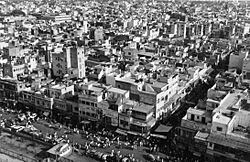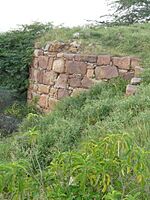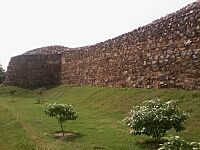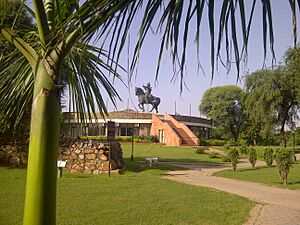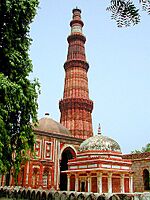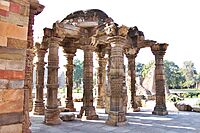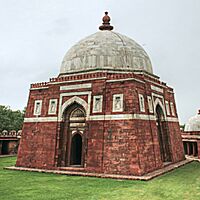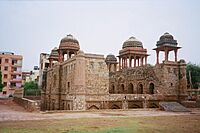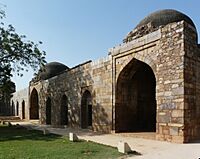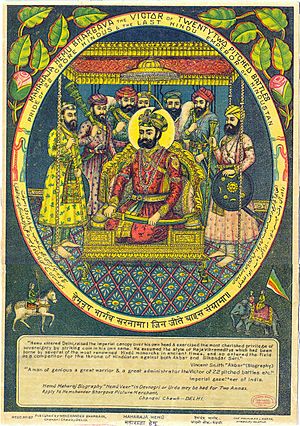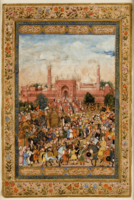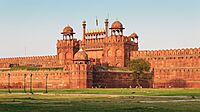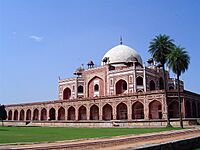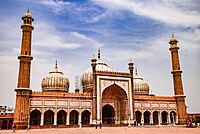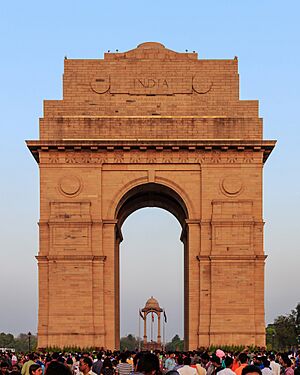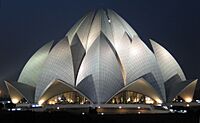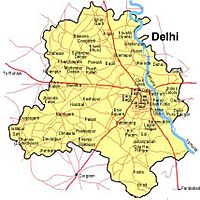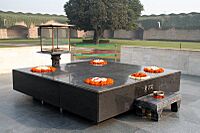History of Delhi facts for kids
| Historical Region of North India Delhi |
|||||||||
| Language | Hindustani (Hindi and Urdu), Punjabi, Bengali, English | ||||||||
| Battles | Battle of Delhi (1303); Mongols vs Khiljis Battle of Delhi (1556) Hemu vs Mughals Battle of Delhi (1737); Marathas vs Mughals Battle of Delhi (1757); Marathas vs Mughals Battle of Delhi (1764); Jats vs Mughals Battle of Delhi (1771); Marathas vs Mughals Battle of Delhi (1783); Sikhs vs Mughals Battle of Delhi (1803); British East India Company vs Marathas Battle of Delhi (1804); British East India Company vs Marathas Battle of Delhi (1857); British East India Company vs Mughals |
||||||||
| Dynasties |
|
||||||||
Delhi has been a really important city in India for a long time. It was the capital for many powerful empires! The story of Delhi officially starts around the 8th century with the Tomar Rajputs. People say Delhi is a city that has been built, destroyed, and rebuilt many times. When invaders came to India, they often attacked Delhi. But then, they would be so impressed by its great location that they would make it their own capital and rebuild it in their own style.
From ancient times to the medieval era, strong rajput families like the Tomaras, Chauhans, and Gautamas ruled Delhi. The Delhi Sultanate was a group of five different dynasties that ruled India with Delhi as their main city.
During the Sultanate period, Delhi became a hub for culture and learning. The Delhi Sultanate ended in 1526. That's when Babur defeated the last Lodi sultan, Ibrahim Lodi, in the first Battle of Panipat. This victory led to the start of the Mughal Empire.
The Mughals ruled this area for about 300 years. In the 16th century, Delhi became less important as the Mughal capital moved to other cities. But the fifth Mughal Emperor, Shah Jahan, built a new walled city called Shahjahanabad within Delhi. He also built famous landmarks like the Red Fort and Jama Masjid. His time as ruler is seen as the peak of the Mughal Empire. After his successor, Aurangzeb, died, the Mughal Empire faced many challenges. They lost large parts of their land to the Marathas, Sikhs, and other local rulers. Delhi was even attacked and looted by Nader Shah. The Jats also took control of many towns south of Delhi. The Marathas captured Delhi in 1757 and ruled it until 1803. That's when the British defeated them in the Second Anglo-Maratha War. In 1803, the British East India Company took control of Delhi.
During British rule, the Mughal Emperor Bahadur Shah II became just a symbolic leader. The Indian Rebellion of 1857 tried to end British rule and declared Bahadur Shah II the Emperor of India. But the British quickly recaptured Delhi and other areas, ending the rebellion. This also marked the start of direct British Rule in India. In 1911, the capital of British India moved from Calcutta to New Delhi. This new city was designed by Edwin Lutyens.
After India gained independence from the British in 1947, New Delhi became the capital of the new Republic of India.
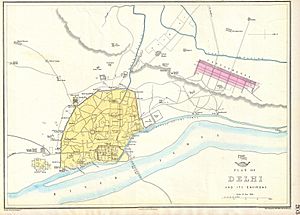
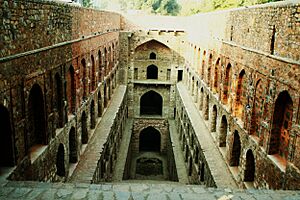
Contents
Ancient History of Delhi
Archaeologists have found signs of ancient pottery in the Red fort area from around 2000 BCE. Around 1200 BCE, people from the Vedic Period lived here. Important ancient sites in Delhi include Anangpur and places near Narela and Nand Nagari where Harappan artifacts were found.
Delhi in Mythology
Many old stories connect Delhi with a legendary city called Indraprastha. This city is mentioned in the ancient Indian epic, the Mahabharata. The village of Indarpat, which existed until the early 1900s, was thought to be the site of Indraprastha, located within the Purana Qila. While there's no clear archaeological proof, the Purana Qila in New Delhi is often suggested as the location of this ancient city.
Medieval Delhi: Rulers and Dynasties
Tomara Dynasty
-
Sculptures from an ancient temple in the Qutb Minar complex.
Anangpal Tomar is credited with founding Delhi in 1052 CE. An old inscription from 1383 in the Delhi Museum confirms that the Tomars founded Delhi.
He started the Tomar Dynasty in the early 8th century. He built his capital at Anangpur village in Haryana. The Anangpur Dam was built during his time, and the Surajkund was built during his son Surajpal's rule.
Chauhan Rajputs Take Control
The Rajput Chahamana (Chauhan) kings from Ajmer conquered Lal Kot in 1180. They renamed it Qila Rai Pithora. However, the Chauhan king Prithviraj III was defeated in 1192 by Muhammad Ghori in the Second Battle of Tarain. This battle firmly established Muslim rule in northern India and weakened the Rajput power in the Indo-Gangetic Plain.
Late Medieval Period: The Delhi Sultanate
The Delhi Sultanate Rulers
Starting in 1206, Delhi became the capital of the Delhi Sultanate. The first ruler was Qutb-ud-din Aybak, who was a former slave. He rose through the ranks to become a general and then the Sultan of Delhi. Qutb-ud-din began building the Qutub Minar, a famous symbol of Delhi, to celebrate his victory. Sadly, he died before it was finished. In the Qutb complex, he also built the Quwwat-al-Islam mosque, which is one of the oldest mosques in India. After the first dynasty, a series of other dynasties from Central Asia and Afghanistan ruled Delhi. These included the Khalji dynasty, the Tughluq dynasty, the Sayyid dynasty, and the Lodi dynasty. They built many forts and towns in Delhi.
-
The Qutub Minar is the world's tallest brick minaret at 72.5 metres. It was started by Qutb-ud-din Aibak in 1192 CE.
-
A mosque tomb built over an ancient temple structure in the Qutb Minar complex.
-
The Tomb of Ghiyasuddin Tughluq inside the Tughlaqabad Fort.
-
Alauddin Khilji's madrasa (school) and Tomb in the Qutb complex.
Timur's Invasion
In 1398, Timur Lang invaded India. He claimed the Muslim rulers of Delhi were too kind to their Hindu subjects. After defeating the armies of Nasiruddin Mahmud, Timur entered Delhi on December 18, 1398. The city was attacked, destroyed, and left in ruins. Over 100,000 prisoners were killed.
End of the Lodi Sultans
In 1526, after the First Battle of Panipat, Babur, a ruler from Fergana, defeated the last Afghan Lodi sultan. This victory led to the start of the powerful Mughal Empire. The Mughals then ruled from Delhi, Agra, and Lahore.
Mughal Rule in Delhi
The Mughal Empire became very strong between the 16th and 18th centuries. After the Delhi Sultanate fell, the Mughals ruled from Agra and Lahore. But in 1648, Delhi became the capital again under Shah Jahan and remained so until the empire declined. During this time, Delhi was a major cultural center. Famous poets like Ghalib lived in the city. The Mughals also built many amazing buildings, including Humayun's Tomb, the Red Fort, and Jama Masjid.
Early Mughal Emperors: Babur and Humayun
The first Mughal Emperors, Babur (1526–1530) and Humayun (1530–1540, then again 1556–57), ruled from Agra, not Delhi.
In the mid-16th century, Mughal rule was interrupted when Sher Shah Suri defeated Humayun. Humayun had to flee to Persia. Sher Shah Suri built the sixth city of Delhi, including the old fort known as Purana Qila. After Sher Shah Suri died in 1545, his son Islam Shah ruled from Delhi. Then Humayun briefly returned to power. However, in 1553, a Hindu leader named Hemu became the Prime Minister and army chief for Adil Shah.
Hemu fought and won 22 battles against rebels and even against the Mughal army in Agra and Delhi. He never lost a battle! After defeating Akbar's army on October 7, 1556, in the Battle of Delhi, Hemu became the ruler of Delhi. He established Hindu rule in North India for a short time and took the title 'Vikramaditya'. But Hemu was defeated in the Second Battle of Panipat by Mughal forces led by Akbar's general, Bairam Khan. This brought Mughal rule back to the region.
From Akbar to Aurangzeb
The third and greatest Mughal emperor, Akbar (1556–1605), continued to rule from Agra. This meant Delhi was less important for a while.
In the mid-17th century, Mughal Emperor Shah Jahan (1628–1658) built a new city called Shahjahanabad. This is the seventh city of Delhi and is now known as Old Delhi. It has many important buildings, like the Red Fort and the Jama Masjid. This city became the capital of the Mughal Empire again from 1638 onwards.
Aurangzeb (1658–1707) became emperor in Delhi in 1658.
After 1680, the Mughal Empire started to decline quickly as the Hindu Maratha Empire grew stronger.
Decline of the Mughal Empire
The Mughal Empire faced many challenges from invaders like the Marathas, Jats, Afghans, and Sikhs. In 1737, Bajirao I led a large Maratha army towards Delhi. The Marathas defeated the Mughals in the First Battle of Delhi. In 1739, the Mughal Empire lost a major battle against the Persian army led by Nader Shah. Nader Shah then attacked and looted Delhi, the Mughal capital. He carried away huge amounts of wealth, including the famous Peacock Throne and the Koh-i-Noor diamond. Nader Shah eventually left India after the Mughal emperor Muhammad Shah I begged him for mercy.
-
The Red Fort was built by Mughal Emperor Shah Jahan in the 17th century. It was the main home for Mughal emperors for almost 200 years.
-
Humayun's Tomb is thought to be an early example of the style used for the Taj Mahal.
-
The Jama Masjid is one of the largest mosques in India.
Maratha Rule in Delhi
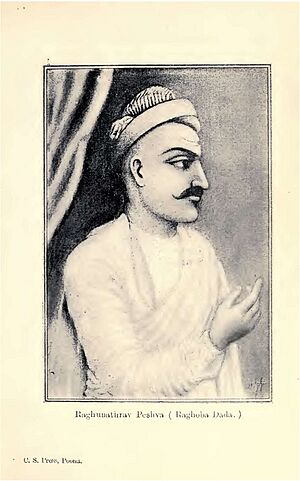
Maratha Control
In 1752, a treaty made the Marathas the protectors of the Mughal throne in Delhi. In 1753, the Jat ruler Suraj Mal attacked Delhi. He defeated the Nawab of Delhi and captured the city. In early 1757, Ahmad Shah Durrani invaded North India for the fourth time. He entered Delhi and held the Mughal emperor captive. In August 1757, the Marathas attacked Delhi again, defeating Najib-ud-Daula and his Afghan army in the Battle of Delhi (1757). Later, Ahmad Shah Durrani conquered Delhi in 1761 after the Third Battle of Panipat, where the Marathas were defeated. A treaty was then made, giving the Marathas control over lands east of the Sutlej river. This gave the Marathas full control over Delhi. In early 1783, under the leadership of Jassa Singh Ahluwalia and Baghel Singh, the Sikh Empire briefly conquered Delhi in the Battle of Delhi (1783).
Maratha Decline and British Takeover
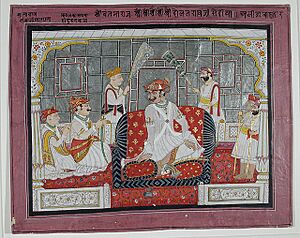
In 1803, during the Second Anglo-Maratha War, the British East India Company defeated the Maratha forces in the Battle of Delhi (1803). This ended Maratha rule over the city. As a result, Delhi came under the control of the British East India Company and became part of the North-Western Provinces. The Mughal Emperor Shah Alam II remained only a symbolic figurehead.
British Rule in Delhi
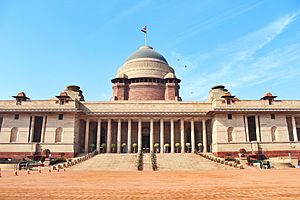
The Revolt of 1857
The Indian Rebellion of 1857 aimed to end the British East India Company's rule in India. On May 11, rebels captured Delhi and declared Bahadur Shah Zafar II the Emperor of India. The Emperor held his first court in many years. However, the British soon returned and attacked Delhi on June 8, 1857. On September 21, Delhi finally fell back to British troops. The city was greatly damaged during the fighting. Afterward, the last Mughal Emperor, Bahadur Shah Zafar II, was captured and sent away to Rangoon.
Delhi then came under the direct control of the British Government in 1857. The remaining Mughal lands became part of British India.
The British Raj and New Delhi
Calcutta was the capital of British India until 1911. But in 1911, at the Delhi Durbar, King George V announced that the capital would move to Delhi. New Delhi, designed by the British architect Edwin Lutyens, was officially opened in 1931. Its construction was delayed because of World War I. A team of architects and engineers worked on this big project.
New Delhi was officially made the seat of the Government of India after India gained independence in 1947.
Delhi After Independence (1947–Present)
During the partition of India in 1947, about 500,000 Hindu and Sikh refugees, mostly from West Punjab, came to Delhi. At the same time, about 300,000 Muslim residents of Delhi moved to Pakistan. Today, many people in Delhi have Punjabi roots and mostly speak Hindi. People continue to move to Delhi from all over India, which helps its population grow more than the birth rate.
In 1956, the States Reorganisation Act, 1956 made Delhi a Union Territory. In 1991, a law changed Delhi's official name to the National Capital Territory of Delhi. This law also gave Delhi its own local government, though with limited powers.
After 1967, there were times of unrest between different communities in Delhi. One notable event was in 1974 in the Sadar Bazar area, which led to conflicts.
In 1966, an inscription from the Mauryan Emperor Ashoka (273-236 BCE) was found near Sriniwaspuri. Two sandstone pillars with Ashoka's messages were brought to Delhi by Firuz Shah Tughluq in the 14th century and are still there today.
-
The Raj Ghat, where Mahatma Gandhi was cremated.
See also
- Agrasen ki Baoli
- Gates of Delhi
- Mehrauli Archaeological Park


